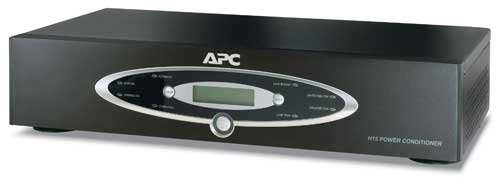
The APC H15 is available at Custom Installation Services! Authorized APC Dealer In Charlotte & surrounding areas
Get to understand what goes into power conditioning as you prepare to add it to your home theater.
You don’t want to have your favorite pieces of electronics gear wiped out during the next thunder and lighting storm, right? Or perhaps the next heat wave when your local electrical grid is going haywire?
Plus, we’re guessing you want everything to reach its optimum performance, so you can hear everything you should be hearing out of that new set of speakers.
Power conditioning and protection products are not going to be the sexiest things in your equipment rack, but they could be among the most important relative to their job. They’ll ensure your gear receives clean electricity, and protect your products from potential damage. And if you’re having a system installed by a custom electronics pro, you can be sure it will include some sort of power product.
Because it’s an overlooked category, we asked our friends at SurgeX to give us a glossary of what to know.
1. Alternating Current (AC) – Electric current that reverses direction periodically, usually many times per second. Used for power distribution because the AC voltage can easily be changed by a transformer.
2. Ampere (Amp) – The practical meter-kilogram-second unit of electric current that is equivalent to a flow of one coulomb per second.
3. Avalanche diode – A type of semiconductor component that is normally open circuit until the voltage increases to the point where the device turns on and conducts current. Similar in operation to MOVs but do not degrade with use. Very reliable as long as they are used strictly within their ratings.
4. Direct current (DC) – Electric current which flows in one direction only through a circuit or equipment. The associated direct voltages, in contrast to alternating voltages, are of unchanging polarity.
5. Brown Out – The IEEE (IEEE Std 1100-1999) recommends avoiding the use of ambiguous terms such as “Brown Out.”
6. Capacitance – The property of a circuit element that permits it to store charge. A capacitor is an example of one such circuit element. A capacitor has high impedance at low frequencies and its impedance decreases as frequency increases, which allows it to differentiate between signal frequencies in applications such as crossover networks.
7. Current – A measure of the amount of electrical charge (in Amps) transferred per unit time. It represents the flow of electrons through a conductive material.
8. Electromagnetic Interference (EMI) – A general type of electric or magnetic interference which is transmitted by conduction or radiation and can be of a very wide frequency range.
9. Ground – A conducting connection, whether intentional or accidental, by which an electric circuit or equipment is connected to the earth, or to some conducting body of relatively large extent that serves in place of the earth.
10. Ground Contamination – The diversion of surge and noise currents to the ground wire, which contaminates the system ground. Surge voltages can couple noise to the ground, which can often enter an audio or video system by causing shield current to flow.
11. Ground Loop – A potentially detrimental loop formed when two or more points in an electrical system that are nominally at ground potential are connected by a conducting path such that either or both points are not at the same ground potential.
12. Hertz (Hz) – The unit of frequency in cycles per second. Used to characterize anything from AC power (50 or 60 Hertz) up to cellular phone radio frequencies (Giga-Hertz)
13. Hospital Grade Receptacle – A receptacle which has a high-impact-resistant face and body, and a higher spring tension in the receptacle contacts. Identified by a green dot on the receptacle face.
14. IEC – (A) IEC stands for the International Electrotechnical Commission: An “organization that prepares and publishes international standards for all electrical, electronic and related technologies.” (B) Commonly used to refer to one of the 13 power connectors described by specification IEC 60320. Most commonly refers to the C13 and C14 connectors used by most computers and many AC-powered electronic devices to connect the AC power.
15. Impedance – A measure for the manner and degree a component resists the flow of electrical current if a given voltage is applied. It is denoted by the symbol Z and is measured in ohms. Impedance differs from simple resistance in that it takes into account possible phase offset.
16. Joules – The standard unit of electrical energy (measured over time). One Joule is equivalent to the heat generated during one second when one Volt is driving one Amp around a circuit.
17. Linear power supply – One type of power supply inside electronic equipment that converts the 120V AC to the DC required by the circuitry. A type of regulated power supply which utilizes a line-frequency transformer. Linear power supplies regulate their output by generating a higher voltage than needed at the output, then reducing it by converting some of the electrical power to heat.
18. Metal Oxide Varistor (MOV) – A disc shaped device which is normally open circuit until the voltage increases to the point where the MOV turns on and conducts current. Originally developed to suppress arcing on relay contacts but used extensively in shunt-mode surge protectors. Have a limited lifetime.
19. National Electrical Manufacturers Association (NEMA) – A US trade organization that develops standards for the electrical manufacturing industry.
20. NRTL (Nationally Recognized Test Laboratory) – A government certified testing agency (such as MET Labs, Intertek/ETL, and TÜV) that tests and certifies equipment to established safety and test standards. Identical in function to UL certification.
21. Parallel Connection – Devices connected together so that the same voltage appears across all devices.
22. Radio Frequency Interference (RF) – Interference which is caused by radio signals.
23. Root Mean Square (RMS) – The value of an AC voltage or current that delivers the equivalent power that a given DC voltage or current delivers.
24. Sag – An RMS reduction in the AC voltage, at the power frequency, for durations from a half cycle to a few seconds. Note: The IEC terminology is dip.
25. Series Connection – Devices connected together in a chain so that the same electric current passes through all devices.
26. Shunt Connection – (Equivalent to Parallel Connection)
27. Shunt Mode Surge Protector – A type of surge protector which uses MOVs, avalanche diodes or gas discharge tubes to conduct surge current to the neutral or ground wire.
28. Spike – The IEEE (IEEE Std 1100-1999) recommends avoiding the use of ambiguous terms such as “Spike”.
29. Suppression Voltage – The maximum peak voltage that will be seen across the active terminals of a suppressor at a specified waveform and source current. It is the remnant voltage the suppressor “lets through” to protected equipment. Products tested to the UL 1449 Standard are assigned a VPR (Voltage Protection Rating) in a range from 330V to 2500V, based upon the product’s suppression voltage.
30. Surge (Transient) – The IEEE (IEEE Std 1100-1999) defines “surge” and “transient” to be analogous terms, as defined as: a subcycle disturbance in the AC waveform that is evidenced by a sharp, brief discontinuity of the waveform.
31. Switch-Mode Power Supply – One type of power supply inside electronic equipment that converts the 120V AC to the DC required by the circuitry. A switch mode supply is smaller and lighter than a linear power supply because it switches the current on and off very fast to generate the DC using a small high-frequency transformer rather than a larger traditional line-frequency power transformer.
32. Toroidal Transformer – A transformer that is constructed around a magnetic core in a toroidal, or donut shape. This geometry produces a more contained magnetic field, which leads to a more efficient and compact design.
33. Transient – A subcycle disturbance in the AC waveform that is evidenced by a sharp, brief discontinuity of the waveform. May be of either polarity and may be additive to, or subtractive from, the nominal waveform.
34. Under Voltage – When used to describe a specific type of long duration variation, refers to an RMS decrease in the AC voltage, at the power frequency, for a period of time greater than 1 min.
35. Underwriter’s Laboratory (UL) – An independent product safety certification organization that writes standards and tests products. Other NRTLs (Nationally Recognized Test Laboratories) may also perform product testing to ensure compliance with standards written by UL.
36. Uninterruptable Power Supply/Source (UPS) – A device that provides battery backup power for continuous equipment operation when the electrical power fails, drops, or rises to an unacceptable voltage level.
37. Volt Ampere (VA) – The standard unit of measurement of apparent electrical power, equal to the product of root-mean-square (RMS) voltage and RMS current.
38. Watts – The standard unit of measurement of real electrical power, which factors in any phase differences between the voltage and current waveforms.
by Robert Archer
http://www.electronichouse.com/article/power_conditioning_101_terms_you_need_to_know/
Custom Installation Services, LLC – Charlotte and Boone NC’s Source For APC & Panamax Sales, Support & Installation!




